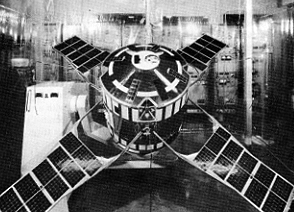
Gamma-ray burst detectors have been carried by elements of the Franco-
Soviet SIGNE program. SIGNE 1 was a package of experiments flown on the
Prognoz 2 satellite; SIGNE 2 was aboard the Prognoz 6. SIGNE 3 was a small
French-built satellite (also known as Gamma D2B and Sneg-3) which was
originally intended to be launched by the French Diamant rocket, but was
actually launched by the Soviets when the Diamant program terminated. Other
SIGNE packages were carried aboard Prognoz 7, Prognoz 9, Venera 11, and
Venera 12.
SIGNE 3 was launched on 17 June 1977. It weighed just 103 kg. It was put
into an orbit with apogee 519 km, perogee 459 km, and inclination 50.66
degrees. The orbital period was 94.4 minutes. The spin stabilized satellite
was a cylinder 0.7 m in diameter and 0.8 m high, with 4 attached solar
panels. Attitude control was provided by cold gas jets. The satellite
reentered the atmosphere on 22 June 1979.
There were 2 instruments onboard: a gamma-ray telescope and a solar UV
experiment. The gamma-ray spectrometer installed on the French SIGNE-3
satellite had 14 differential channels in the 20 keV to 10 MeV range and
256 channels for amplitude analysis in the 200 keV to 2.5 MeV range.
Combinations of data from the SIGNE experiments with data from other
satellites such as Helios 2 allowed for the localizations of gamma-ray
burst events.